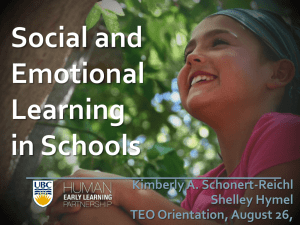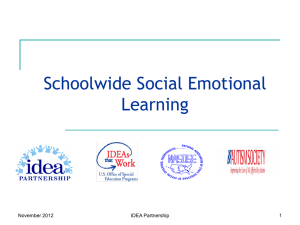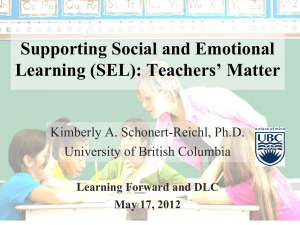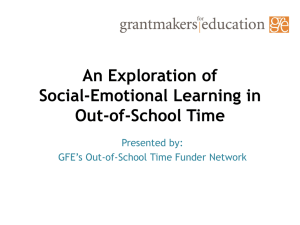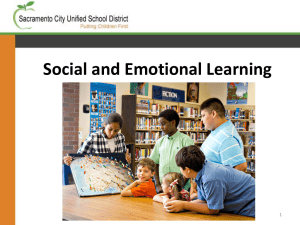Social and Emotional Learning: Key to Mental Health
advertisement
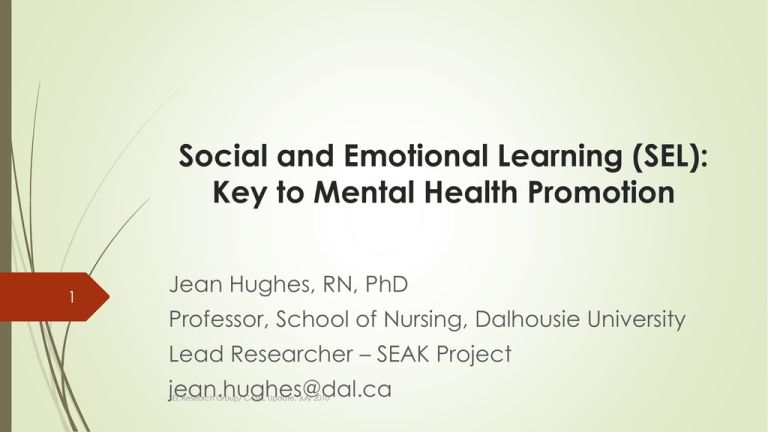
Social and Emotional Learning (SEL): Key to Mental Health Promotion 1 Jean Hughes, RN, PhD Professor, School of Nursing, Dalhousie University Lead Researcher – SEAK Project jean.hughes@dal.ca SEL Research Group/ CASEL Update, July 2010 2 Social and Emotional Learning … Key Life Skills SEL includes the knowledge, attitudes and skills necessary to: understand and manage emotions, set and achieve positive goals, feel and show empathy for others, establish and maintain positive relationships, make responsible decisions. Collaborative for Academic, Social and Emotional Learning (CASEL) SEL Competencies 3 Self-awareness Self-management Social awareness Relationship skills Responsible decision making CASEL 4 SEL Skills Assist Mental Health Promotion: Enhance capacity to take control Foster individual resilience Foster individual protective factors 5 Why are SEL skills so important? Neuropsychological models argue that children’s neurological functioning affects: the regulation of Strong emotions Social function Cognitive function Behavioural function Riggs et al., 2006 6 Why are SEL skills so important? Research shows that environmental stress during childhood & adolescence has substantial effects on the operation of the neuroendocrine system and that these effects are likely to have long term impact on both cognitive and social-emotional functioning Shankoff, et al., 2009 in Bradshaw, et al., 2012 7 Why are SEL skills so important? Fortunately brain function and its behavioral outcomes are malleable during these developmental stages. Therefore interventions can assist when focused on: THE ENVIRONMENT - Strengthen children’s social– ecologies (responsive parenting, caring & welcoming schools) SEL SKILLS - support children’s development of Social & emotional regulation & coping abilities Bradshaw, et al., 2012 8 Do SEL interventions work… What does the evidence say? Meta-analysis: 213 school-based, universal SEL programs 270,034 students - kindergarten through high school. Durlak, et Al., 2011 9 Results: Compared to controls, SEL participants demonstrated significant improvement in: social and emotional skills, attitudes, behavior, academic performance that reflected an 11percentile-point gain in achievement. Durlak, et al., 2011 10 Key Findings Classroom Teachers Only when school staff conduct the intervention does academic performance improve significantly. SEL Research Group/ CASEL Update, July 2010 11 Key Findings Program Implementation Quality The benefits of effective SEL programs are reduced when schools do not adopt evidence-based programs do not implement these programs with fidelity. SEL Research Group/ CASEL Update, July 2010 12 Key Findings Maximize the SEL and academic outcomes by combining: support to school personnel who deliver evidence-based SEL programming sound educational policy SEL Research Group/ CASEL Update, July 2010 13 Best Evidence re SEL Programs… Positive change in students’ developmental health and well-being are best achieved from programs that are: Focused on social, cognitive and emotional processes School based Multi Year Conduct Problem Prevention Research. (2010); Jones, et al., 2011 14 Best Evidence re SEL Programs… Universal (whole school approach) builds common language (culture) generalizes competence – to other courses, outside classroom/school SEL Research Group/ CASEL Update, July 2010 15 Best Evidence re SEL Programs Cont’d. Provide: a manualized curriculum opportunities for practice Teacher/staff training On-going mentoring/support School Principal – program champion SEL Research Group/ CASEL Update, July 2010 16 Such Commitment Requires Policy Change 17 What type of policy is critical to sustain SEL? Policies at many different levels (federal, provincial and local) play a key role in determining the priority that schools give to SEL in teacher preparation – B. Ed. Programs in the curriculum in assessing students’ learning of the basic SEL competencies. 18 What type of policy is critical to sustain SEL? Provincial learning standards a primary driver of curriculum and assessment. Provinces are increasingly including SEL in their standards… but need to ensure: evidence-based programs implementation fidelity. 19 One SEL Program: PATHS Promoting Alternative THinking Strategies Kusche & Greenberg, 1994. 20 One SEL Program: PATHS Promoting Alternative THinking Strategies Highly Ranked Evidence-Based SEL Program Blueprints Project of the Center for the Study and Prevention of Violence, University of Colorado Model Program – highest possible rating Only violence-prevention curriculum for elementary-age children to achieve this rating PATHS 21 National Dropout Prevention Center/Network Model Program – highest possible rating Collaborative for Academic, Social, and Emotional Learning (CASEL) Select Program – highest possible rating Centers for Disease Control and Prevention (CDC) Best Practices Program 22 PATHS PATHS is rooted in developmental neuroscience showing that: Children experience intense emotions before having the cognitive skills to verbalize and control emotions. 23 PATHS The PATHS curriculum is centered on the ABCD model of development (affective/behaviour/cognitive/dynamic) arguing that: affect, vocabulary, and cognition interact to create social and emotional competence 24 PATHS Promoting Alternative THinking Strategies Elementary school-wide program Kindergarten – Grade 6 Manualized curriculum Delivered by trained teachers two 20 minute lessons each week all year, every year 25 Summary of key PATHS research findings Compared to students from control schools, PATHS students show: Enhanced Emotional Understanding Enhanced Pro-social Behaviour better understand social problems and create effective solutions reduced aggression and disruptiveness SEL Research Group/ CASEL Update, July 2010 26 Summary of key PATHS research findings Enhanced Cognitive Skills and Academic Performance effective problem solving, thinking and planning skills, and controlled impulses academic engagement SEL Research Group/ CASEL Update, July 2010 27 Summary of key PATHS research findings Enhanced Mental Health diminished internalizing problems such as anxiety and sadness decreased externalizing problems such as conduct disorder, Oppositional Deviance Disorder or ODD, hyperactivity, frustration SEL Research Group/ CASEL Update, July 2010 28 PATHS In Action The SEAK Project: PATHS In Canada 29 Contact: Jean Hughes, RN, PhD, Dalhousie University, Halifax, NS, Canada jean.hughes@dal.ca jean.hughes@dal.ca Funded by the SEL Research Group/ CASEL Update, July 2010 Public Health Agency of Canada 30 Socially and Emotional Aware Kids: The SEAK Team Canadian Mental Health Assoc. Nova Scotia Division ◦ Gail Gardiner – Executive Director CMHA NS Division Dalhousie University ◦ Dr. Jean Hughes – Lead Researcher/ Principal Investigator ◦ Dr. Sophie Jacques – Associate Researcher ◦ Dr. Noriyeh Rahbari – SEAK Research Coordinator Our Project: SEAK 31 Socially and Emotionally Aware Kids Vision: Socially and Emotionally Competent Children in a Healthy Community. Approach: Based in Population Health & Health Promotion. Core Intervention: Promoting Alternative Thinking Strategies (PATHS) 32 SEAK – Objectives 4 Years Increase the social and emotional competence of children in project sites identified as having health inequalities . Strengthen community capacity to integrate mental health promotion. Increase community capacity for leadership, collaboration and accountability in population health innovation diffusion related to social and emotional learning. 33 SEAK – Objectives Provide evidence to support the innovation and inform policy and service change over the long term. Advance knowledge on population health innovation diffusion related to social and emotional learning. 34 Project Sites: Nova Scotia, Manitoba and Alberta PATHS Intervention Schools Receive the PATHS program (K- grade 6) 5 community sites (approx. 350 students/site) 2 sites delivering PATHS (4yrs, 13 yrs) 3 new sites – phase in PATHS Wait-List schools Wait-listed for 1-2 years and then receive PATHS intervention At least100 students/school Total = 1700+ Students (numbers vary by site) 35 Outcome indicators: Chosen to enhance buy-in from key stakeholders SEL ◦ During PATHS ◦ Long-term follow up after PATHS (SEL & Risk) School ◦ Climate ◦ Discipline ◦ Academics, school retention Health - Obesity (BMI) Parent mental well-being Health service use Economic Analysis (cost-benefit) of PATHS Quantitative and qualitative measures Policy/Sustainability Issues Identified by SEAK Project 36 Curriculum Needs to be formally integrated into curriculum of Educational authority (provincial, national level) Focus Build core skills to explore emotions and relationships & focus on strengths rather than interventions to address specific problems (bullying/ suicide) that focus only on symptoms 37 Policy/Sustainability Issues Identified by SEAK Project Financial Collaborations ◦ Government multiple sectors- education, health, recreation, justice, etc. Focus: cost-effectiveness ◦ Corporate Focus: PATHS builds desired employee skills ◦ Not for Profit, Foundations Focus: citizenship Scale Up 38 It really does take a village to raise a healthy child! 39 References Bradshaw, et al., Goldweber, A., Fishbein, D., Greenberg, M. (2012). Infusing developmental neuroscience into school-based prevention interventions: Implications and future directions. Journal of Adolescent Health, 51: S41S47. Conduct Problem Prevention Research. (2010). The effects of a multiyear universal social-emotional learning program: The role of student and school characteristics. Journal of Consulting and Clinical Psychology. 78(2): 156168. Collaborative for Academic, Social and Emotional Learning (CASEL) http://www.casel.org/social-and-emotional-learning Durlak, J. A., Weissberg, R. P., Dymnicki, A. B., Taylor, R. D. & Schellinger, K. B. (2011). The impact of enhancing students’ social and emotional learning: A meta-analysis of school-based universal interventions. Child Development, 82: 405–432. SEL Research Group/ CASEL Update, July 2010 40 References Jones, S. Brown, J., Aber, J. L. (2011). Two-year impacts of a universal school-based social-emotional and literacy intervention: An experiment in translational developmental research. Child Development, 82(2): 533-554. Kusche & Greenberg, 1994. The PATHS Curriculum. Seattle, WA: Developmental Research and Programs. Riggs, N., Greenberg, M., Kusche, C., Pentz, M.A. (2006). The mediational role of neurocognition in the behavioural outcomes of a social-emotional prevention program in elementary school students: Effects of the PATHS curriculum. Prevention Science. 7(1): 91-102. SEL Research Group (2010). The benefits of school-based social and emotional learning programs: Highlights from a forthcoming CASEL Report. Chicago: University of Illinois at Chicago SEL Research Group & The Collaborative for Academic, Social and Emotional Learning. SEL Research Group/ CASEL Update, July 2010


